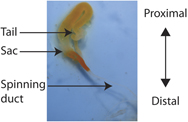Crossref Citations
This article has been cited by the following publications. This list is generated based on data provided by
Crossref.
Steins, Anne
Dik, Pieter
Müller, Wally H.
Vervoort, Stephin J.
Reimers, Kerstin
Kuhbier, Jörn W.
Vogt, Peter M.
van Apeldoorn, Aart A.
Coffer, Paul J.
Schepers, Koen
and
Liu, Xiaohua
2015.
In Vitro Evaluation of Spider Silk Meshes as a Potential Biomaterial for Bladder Reconstruction.
PLOS ONE,
Vol. 10,
Issue. 12,
p.
e0145240.
Kumar, Vikas
Krishna, K. Vijaya
Khanna, Shruti
and
Joshi, Khashti Ballabh
2016.
Aggregation propensity of amyloidogenic and elastomeric dipeptides constituents.
Tetrahedron,
Vol. 72,
Issue. 35,
p.
5369.
Scavuzzo, Joseph J.
Yan, Xuesong
Zhao, Yihong
Scherger, Jacob D.
Chen, Junyi
Zhang, Shuo
Liu, Hao
Gao, Min
Li, Tao
Zhao, Xiuying
Hamed, Gary R.
Foster, Mark D.
and
Jia, Li
2016.
Supramolecular Elastomers. Particulate β-Sheet Nanocrystal-Reinforced Synthetic Elastic Networks.
Macromolecules,
Vol. 49,
Issue. 7,
p.
2688.
Siddaiah, Arpith
and
Menezes, Pradeep L.
2016.
Advances in Bio-inspired Tribology for Engineering Applications.
Journal of Bio- and Tribo-Corrosion,
Vol. 2,
Issue. 4,
Ko, Frank K.
and
Wan, Lynn Y.
2018.
Handbook of Properties of Textile and Technical Fibres.
p.
185.
Pan, Cheng-Tang
Yen, Chung-Kun
Hsieh, Ming-Chun
Wang, Shao-Yu
Chien, Chi-Hui
Huang, Jacob Chih-Ching
Lin, Liwei
Shiue, Yow-Ling
and
Kuo, Shiao-Wei
2018.
Energy Harvesters Incorporating Silk from the Taiwan-Native Spider Nephila pilipes.
ACS Applied Energy Materials,
Whaite, Alessandra D.
Wang, Tianfang
Macdonald, Joanne
Cummins, Scott F.
and
Ho, Paulo Lee
2018.
Major ampullate silk gland transcriptomes and fibre proteomes of the golden orb-weavers, Nephila plumipes and Nephila pilipes (Araneae: Nephilidae).
PLOS ONE,
Vol. 13,
Issue. 10,
p.
e0204243.
Abd Ellah, Noura H.
Abd El‐Aziz, Fatma El‐Zahraa A.
Abouelmagd, Sara A.
Abd El‐Hamid, Basma N.
and
Hetta, Helal F.
2019.
Spidroin in carbopol‐based gel promotes wound healing in earthworm's skin model.
Drug Development Research,
Vol. 80,
Issue. 8,
p.
1051.
Verma, Paras
Panda, Biswajit
Singh, Kamal P.
and
Pandit, Shashi B.
2021.
Optimal Protein Sequence Design Mitigates Mechanical Failure in Silk β-Sheet Nanocrystals.
ACS Biomaterials Science & Engineering,
Vol. 7,
Issue. 7,
p.
3156.
Fitzgerald, Amy
Proud, Will
Kandemir, Ali
Murphy, Richard J.
Jesson, David A.
Trask, Richard S.
Hamerton, Ian
and
Longana, Marco L.
2021.
A Life Cycle Engineering Perspective on Biocomposites as a Solution for a Sustainable Recovery.
Sustainability,
Vol. 13,
Issue. 3,
p.
1160.
Candau, Nicolas
Galland, Sylvain
Cretenoud, Julien
Balog, Sandor
Michaud, Véronique
Chenal, Jean-Marc
Lame, Olivier
Plummer, Christopher J. G.
and
Frauenrath, Holger
2021.
High-performance polyamides with engineered disorder.
Polymer Chemistry,
Vol. 12,
Issue. 44,
p.
6426.
